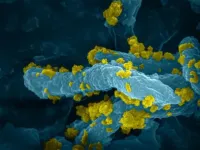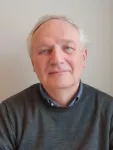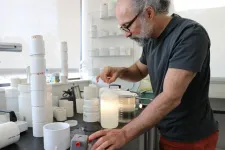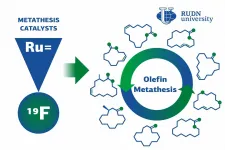(Press-News.org) SARS-CoV-2, the virus responsible for the COVID-19 pandemic, arrived one year ago and turned our lives upside-down.
While worldwide vaccination programs are currently ongoing, we do not yet know for how long the vaccine will provide immune protection against infection, and if the currently approved vaccines can provide protection against the emerging virus variants.
In addition, it appears that vaccines cannot prevent illness for people who have already been infected. In contrast to vaccines, there are currently no effective drugs that act against the virus SARS-CoV-2.
New research by Associate Professor Jasmin Mecinovic and co-workers from the Department of Physics, Chemistry and Pharmacy, University of Southern Denmark, now presents a compound that might provide a basis for the development of drugs against COVID-19.
The work has been recently published in Chemical Communications.
- Our approach is based on mimicking Nature, and the idea is to prevent the virus from entering the body's cells. If the virus does not enter the cells, it cannot survive. Instead, the immune system destroys the viral particles, thus preventing an infection, explains Jasmin Mecinovic.
SARS-CoV-2 belongs to the family of coronaviruses, which are named after their characteristic crown shaped envelope that shields its RNA from being damaged. This crown is made up out of viral spike proteins, which act as the lock-picks used by the virus to break into a host cell.
The SARS-CoV-2 spike protein specifically interacts with an enzyme, called ACE2 receptor, to initiate cell entry and infection.
The ACE2 receptor is found on the surface of cells in many different tissues and is especially common in the lungs. For this reason, SARS-CoV-2 infection leads to (severe) respiratory disease symptoms for many people.
Mecinovic and colleagues have found that peptides (a small part of protein), made to look exactly like the ACE2 receptor can act as a decoy and prevent binding of the of the SARS-CoV-2 spike protein.
- This suggests that molecular decoys based on the ACE2 receptor might be an effective therapeutic to prevent infection by the virus, says PhD student Marijn Maas, the first author of the article.
- Getting a new drug to the market is a long journey. Next step is to continue studying our synthetic peptide - for example by making variations of it to see if we can improve its potency, says Jasmin Mecinovic.
INFORMATION:
Jasmin Mecinovic is an Associate Professor in Medicinal Chemistry, Dept of Physics, Chemistry and Pharmacy, University of Southern Denmark. His research is supported by European Research Council, Lundbeck Foundation, Novo Nordisk Foundation and Carlsberg Foundation.
Decarbonizing the economy and achieving the transition from fossil fuels to renewable energies is one of the most urgent global challenges of the 21st century. Hydrogen can play a key role in this process as a promising climate-neutral energy vehicle. Yet, the so-called green hydrogen economy requires that hydrogen production be based exclusively on renewable energy. In addition, it should ideally not use expensive and rare metal catalysts, whose production has severe environmental consequences. To address this challenge, ITQB NOVA researchers Inês Cardoso Pereira and Mónica Martins are working on an innovative technology to produce hydrogen from light using non-photosynthetic microorganisms.
Hydrogen offers exciting new possibilities as an energy vehicle, ...
The Event Horizon Telescope (EHT) collaboration, a multinational team of over 300 scientists including two astrophysicists from the University of the Witwatersrand (Wits University), has revealed today a new view of the massive object at the centre of the M87 galaxy: how it looks in polarised light.
This is the first time astronomers have been able to measure polarisation, a signature of magnetic fields, this close to the edge of a black hole. The observations are key to explaining how the M87 galaxy, located 55 million light-years away, is able to launch energetic jets from its core.
"We are now seeing the next crucial piece of evidence to understand how magnetic fields behave around black holes, and how activity in this very compact region of space can drive powerful ...
The Event Horizon Telescope (EHT) collaboration, who produced the first ever image of a black hole, has today revealed a new view of the massive object at the centre of the Messier 87 (M87) galaxy: how it looks in polarised light. This is the first time astronomers have been able to measure polarisation, a signature of magnetic fields, this close to the edge of a black hole. The observations are key to explaining how the M87 galaxy, located 55 million light-years away, is able to launch energetic jets from its core.
"We are now seeing the next crucial piece of evidence to understand ...
A new study from the University of Bergen (UiB) shows that the way young people view their bodies have a great impact on their BMI.
In a two-year follow up study among 1225 Norwegian adolescents in their early teens, professor Eivind Meland and his team examined how body mass index, self-esteem and self-rated health were mutually impacted and influenced by body dissatisfaction.
"We revealed that positive self-image and self-esteem protected against weight gain", professor emeritus Meland says.
The girls had in general lower body confidence than boys, the study shows.
Body dissatisfaction
The eager to be thinner, dieting, and wanting to change something with the body all impaired self-rated health ...
A new study shows that when people replace their old couch with a new one that has no added flame retardants, levels of the harmful chemicals in household dust drop significantly. Replacing the foam inside the couch cushions is also just as effective. The findings confirm that choosing healthier furniture without flame retardants can make a big difference in people's--especially children's--everyday exposures to these toxic chemicals.
"We've long suspected that couches are a major source of toxic chemicals in dust. Now, for the first time, we have evidence demonstrating the positive impacts of replacing old furniture containing flame retardants," ...
What is the world made of? This question, which goes back millennia, was revisited by theoretical physicist Steven Weinberg from the University of Texas in Austin, TX, USA in the first of an international seminar series, 'All Things EFT'. Weinberg's seminar has now been published as an article in the journal EPJ H.
And Weinberg is well placed to discuss both Effective Field Theories (EFTs) and the nature of the Universe, as he shared the 1979 Nobel Prize for Physics for developing a theory to unify the weak and electromagnetic interactions between elementary particles. This fed into the development of the ...
Ruptures of the carotid artery (cervical artery dissection) are the most common cause of stroke in people under 50 years of age, with an annual incidence of 2-3 cases per 100,000 persons. Salicylic-acid preparations (acetylsalicylic acid: aspirin, Aspegic) and blood-thinning medication (anticoagulants) are used for treatment. The multicenter therapy study "Biomarkers and Antithrombotic Treatment in Cervical Artery Dissection (TREAT-CAD, NCT02046460)" investigated whether dissections - tears in the wall of vessels supplying blood to the brain - can be treated with aspirin or whether more complex blood thinning (anticoagulation) ...
Copepods are tiny crustaceans about the size of a grain of rice, but they are one of the most important parts of the Earth's aquatic ecosystems. Their behavior and interaction with the environment, however, remains a relative mystery. Now, a recent paper published in the Journal of Experimental Biology sheds new light on how these miniature marvels move and cluster in the ocean.
Researchers from Bigelow Laboratory of Ocean Sciences and the Georgia Institute of Technology found that the copepods gather around small vortexes in the ocean, a finding which could have significant implications for the food web.
"We're getting at a mechanism that helps us understand how the ecosystem ...
Chemists from RUDN University found out that fluorine and fluoroalkyl groups increase the efficiency of catalysts in metathesis reactions that are used in the pharmaceutical industry and polymer chemistry. The team also identified fluorine-containing compounds that can simplify the purification of the catalyst from the reaction product, making it reusable. The results of the study were published in the Russian Chemical Reviews journal.
Many medicinal drugs and polymers are based on olefins, organic compounds with a double bond between carbon atoms. To obtain useful substances from them, scientists used the metathesis reaction. In the course of metathesis, ...
New research from the University of Kent and Leeds Beckett University has found that feelings of shame and stigmatisation at the idea of contracting Covid-19 are linked to lower compliance of social distancing and the likelihood of reporting infection to authorities and potential contacts in Italy, South Korea and the USA.
In contrast, the study found that individuals who trust their Government's response to the Covid-19 pandemic and feel a mutual solidarity are more likely to report Covid-19 contraction to authorities and acquaintances.
In Italy and South Korea, individuals are also more likely to follow social distancing regulations if they trust their Government's response to the pandemic, while in the USA, trust does not lead to social distancing compliance. This could ...





